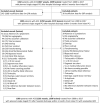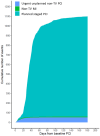Quantitative Flow Ratio to Predict Non-Target-Vessel Events Before Planned Staged Percutaneous Coronary Intervention in Patients With Acute Coronary Syndrome
- PMID: 38156592
- PMCID: PMC10863833
- DOI: 10.1161/JAHA.123.031847
Quantitative Flow Ratio to Predict Non-Target-Vessel Events Before Planned Staged Percutaneous Coronary Intervention in Patients With Acute Coronary Syndrome
Abstract
Background: The optimal time point of staged percutaneous coronary intervention (PCI) among patients with acute coronary syndrome (ACS) remains a matter of debate. Quantitative flow ratio (QFR) is a novel noninvasive method to assess the hemodynamic significance of coronary stenoses. We aimed to investigate whether QFR could refine the timing of staged PCI of non-target vessels (non-TVs) on top of clinical judgment for patients with ACS.
Methods and results: For this cohort study, patients with ACS from Bern University Hospital, Switzerland, scheduled to undergo out-of-hospital non-TV staged PCI were eligible. The primary end point was the composite of non-TV myocardial infarction and urgent unplanned non-TV PCI before planned staged PCI. The association between lowest QFR per patient measured in the non-TV (from index angiogram) and the primary end point was assessed using multivariable adjusted Cox proportional hazards regressions with QFR included as linear or penalized spline (nonlinear) term. QFR was measured in 1093 of 1432 patients with ACS scheduled to undergo non-TV staged PCI. Median time to staged PCI was 28 days. The primary end point occurred in 5% of the patients. In multivariable analysis (1018 patients), there was no independent association between non-TV QFR and the primary end point (hazard ratio, 0.87 [95% CI, 0.69-1.05] per 0.1 increase; P=0.125; nonlinear P=0.648).
Conclusions: In selected patients with ACS scheduled to undergo staged PCI at a median of 4 weeks after index PCI, QFR did not emerge as an independent predictor of non-TV events before planned staged PCI. Thus, this study does not provide conceptual evidence that QFR is helpful to refine the timing of staged PCI on top of clinical judgment.
Registration: URL: https://www.clinicaltrials.gov; Unique identifier: NCT02241291.
Keywords: acute coronary syndrome; multivessel disease; quantitative flow ratio; staged percutaneous coronary intervention.
Figures




Similar articles
-
Effect of Timing of Staged Percutaneous Coronary Intervention on Clinical Outcomes in Patients With Acute Coronary Syndromes.J Am Heart Assoc. 2021 Dec 7;10(23):e023129. doi: 10.1161/JAHA.121.023129. Epub 2021 Nov 24. J Am Heart Assoc. 2021. PMID: 34816730 Free PMC article.
-
Prognostic Implications of Prestent Pullback Pressure Gradient and Poststent Quantitative Flow Ratio in Patients Undergoing Percutaneous Coronary Intervention.J Am Heart Assoc. 2022 Jun 7;11(11):e024903. doi: 10.1161/JAHA.121.024903. Epub 2022 Jun 3. J Am Heart Assoc. 2022. PMID: 35656982 Free PMC article. Clinical Trial.
-
Feasibility and diagnostic reliability of quantitative flow ratio in the assessment of non-culprit lesions in acute coronary syndrome.Int J Cardiovasc Imaging. 2021 Jun;37(6):1815-1823. doi: 10.1007/s10554-021-02195-2. Epub 2021 Mar 2. Int J Cardiovasc Imaging. 2021. PMID: 33651231 Free PMC article.
-
Effects of diabetes mellitus on post-intervention coronary physiological assessment derived by quantitative flow ratio in patients with coronary artery disease underwent percutaneous coronary intervention.Diabetes Res Clin Pract. 2022 Apr;186:109839. doi: 10.1016/j.diabres.2022.109839. Epub 2022 Mar 21. Diabetes Res Clin Pract. 2022. PMID: 35331810
-
Non-invasive imaging software to assess the functional significance of coronary stenoses: a systematic review and economic evaluation.Health Technol Assess. 2021 Sep;25(56):1-230. doi: 10.3310/hta25560. Health Technol Assess. 2021. PMID: 34588097
References
-
- Byrne RA, Rossello X, Coughlan JJ, Barbato E, Berry C, Chieffo A, Claeys MJ, Dan G‐A, Dweck MR, Galbraith M, et al. 2023 ESC Guidelines for the management of acute coronary syndromes: developed by the Task Force on the management of acute coronary syndromes of the European Society of Cardiology (ESC). Eur Heart J. 2023;44:3720–3826. doi: 10.1093/eurheartj/ehad191 - DOI - PubMed
-
- Engstrøm T, Kelbæk H, Helqvist S, Høfsten DE, Kløvgaard L, Holmvang L, Jørgensen E, Pedersen F, Saunamäki K, Clemmensen P, et al. Complete revascularisation versus treatment of the culprit lesion only in patients with ST‐segment elevation myocardial infarction and multivessel disease (DANAMI‐3—PRIMULTI): an open‐label, randomised controlled trial. Lancet. 2015;386:665–671. doi: 10.1016/S0140-6736(15)60648-1 - DOI - PubMed
-
- Gershlick AH, Khan JN, Kelly DJ, Greenwood JP, Sasikaran T, Curzen N, Blackman DJ, Dalby M, Fairbrother KL, Banya W, et al. Randomized trial of complete versus lesion‐only revascularization in patients undergoing primary percutaneous coronary intervention for STEMI and multivessel disease: the CvLPRIT trial. J Am Coll Cardiol. 2015;65:963–972. doi: 10.1016/j.jacc.2014.12.038 - DOI - PMC - PubMed
Publication types
MeSH terms
Associated data
LinkOut - more resources
Full Text Sources
Medical
Miscellaneous

